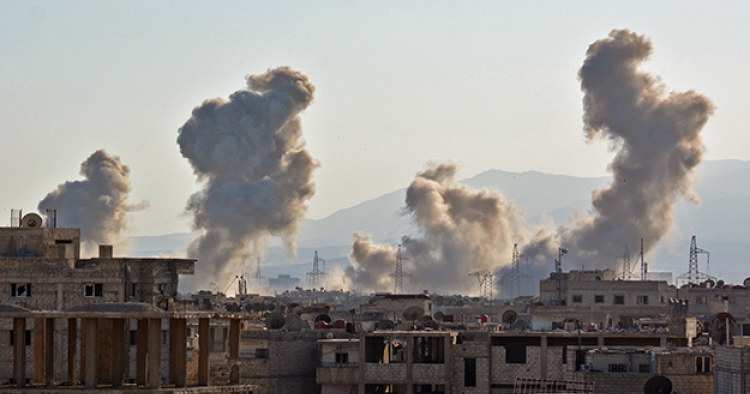In this week's Monday Briefing, MEI experts Charles Lister, Alex Vatanka, Randa Slim, and Marvin G. Weinbaum provide analysis on the US's silence amid the Assad regime's expansion, the Iranian president's trip to Europe, the uptick in violence after Iraq's elections, and the upcoming Pakistani parliamentary elections.
The decline of the US’s role in Syria
Charles Lister, Senior Fellow
After two weeks of intensive military operations backed heavily by Russia, the Assad regime finds itself in control of at least 60 percent of southern Syria. More than 270,000 civilians have been displaced by the regime advances amid virtual international silence—deemed by many to represent a de facto green light. Although the U.S. government led the negotiation of southern Syria’s de-escalation agreement in 2017, it has recently made clear that it would not protect or defend its allies from regime assault.
Having focused heavily on advancing in eastern Daraa, the regime is now pivoting west while Russia pushes hard on multiple complex tracks of “reconciliation” negotiations, in which opposition communities are expected to surrender, disarm, and submit to regime rule. By conducting separate talks with separate communities, interspersed and enforced with coordinated bombing campaigns, Russia is pursuing a divide and conquer strategy—achieving individual surrenders that each serve to weaken and divide the remaining opposition movement. In many cases, Moscow has been accused of exaggerating the terms of opposition surrenders in order to undermine their broader unity of cause.
Both Jordan or Israel have locked down their borders to all internally displaced persons, leaving 270,000 stranded in no man’s land, with little shelter or provisions amid the summer heat. Intensifying civilian suffering may also accelerate the process of armed group capitulations, further emboldening the Assad regime’s military-first strategy. Despite Jordanian and Israeli concerns, Iran-backed militias also appear undeterred from playing a role, with some publicly celebrating their operations. As the pro-regime offensive pushes west, closer to Israel, concurrent Iranian proxy activity will draw a severe Israeli response.
Despite clear and present interests in the southern Syrian region, the U.S. government remains silent—effectively abandoning Syrian, Jordanian, and Israeli allies to deal with the consequences alone.
Rouhani’s European overture
Alex Vatanka, Senior Fellow
Iran’s President Hassan Rouhani is visiting Switzerland and Austria, and he is desperate for some good news. The U.S. decision to reimpose sanctions on Iran is having a debilitating impact on the Iranian economy. Not are only foreign businesses leaving Iran in droves, but the domestic mood is one of deep worry. Unsure about what will come next, local businesses have massively cut back their operations and are hanging onto their dollars and stocks to see what will happen. This has prompted Rouhani to order the release of strategic reserves of goods such as flour and cooking oil to the market to prevent further price increases.
On this European trip, planned before the U.S. reimposed sanctions, Rouhani will likely hear more assurances that Europe will stay committed to the 2015 nuclear deal that President Donald Trump discarded. That is welcome political symbolism but will not help Rouhani much with his anxious public back home. That is why Rouhani will push for two specific promises from the Europeans: that they continue to buy Iranian oil in significant volumes, and that they find a way to transfer payment to Iran without the U.S. scuttling the arrangement. The European Union is soon expected to present its package to save the nuclear deal but so far the Iranians have been less than satisfied with what the Europeans have put on the table.
Meanwhile, for the first time since January, angry protests have once again erupted in different parts of Iran. They have nothing to do with Trump or Europe but are the result of deep mismanagement—economic, political, and otherwise—by the Iranian authorities.
Terrorism and turmoil in Iraq
Randa Slim, Director of the Initiative for Track II Dialogues
History repeats itself in Iraq: once again, a frail political process is creating a vacuum for terrorists to mine. While Baghdad politicians are focused on the vote recount and government formation, terrorism has claimed the lives of 76 civilians and injured 129 in June alone, according to a report from the U.N. Assistance Mission in Iraq. The worst violence occurred in the provinces of Diyala and Kirkuk and kidnappings took place in Salahuddin province, leading to speculations of an ISIS resurgence in the area.
Ballot warehouses are also being targeted. These attacks are primarily aimed at disrupting the manual vote recount process set to begin this week and at delegitimizing an electoral process already beset by fraud allegations. After an Iraqi ballot box depot was set on fire in Baghdad on Jun. 10, three coordinated explosions on Jul. 1 targeted the Kirkuk ballot warehouse, killing at least one person and injuring more than 20 others.
This persistent violence will force Iraqi politicians and leaders of the Iran-backed Popular Mobilization Units (PMUs) who are calling for a withdrawal of U.S. forces from Iraq to dial back their demands on the grounds that U.S. assistance is still needed to fight ISIS. Simultaneously, calls by Iraqi politicians and civil society to dismantle and disarm the PMUs will also face resistance on the grounds that the ISIS threat that brought them to the fore in the first place has not yet been defeated.
Despite the talk of clashing Iranian and U.S. interests in Iraq, the two most influential external stakeholders in Iraq still share an interest in denying ISIS a safe haven.
Pakistan’s political circus
Marvin G. Weinbaum, Director for Afghanistan and Pakistan Studies
With Pakistan’s National Assembly elections three weeks away and campaigning in full swing, the outcome remains uncertain and the country’s political scene is in disarray. The landscape, once a reliable two-party system, is marked by divided political parties, shifting alliances, fresh political movements, and an unusually large number of independent candidates. Unclear is how a governing coalition will be built and how stable it will be. Also poorly understood is the full extent to which the military has already shaped the outcome of the election, particularly its role in the judiciary’s efforts to dismantle the former ruling party, the Pakistan Muslim League (PML-N).
More known is that Pakistan’s Punjab province, which holds 174 of the 272 directly elected seats, will continue to weigh heavily as a factor in determining the final results. Traditionally, the PML-N has held a near lock on the province. But Imran Khan’s Pakistan Tehrik-e-Insaf (PTI) is believed to be making sharp inroads in this PML-N stronghold. The once-ascendant Pakistan People’s Party is expected to retain its usual bloc of seats in the rural areas of Sind province—but nothing more. Predictably, the election will be marred by violence and media manipulation, and although old-fashioned vote rigging may decline, one or more of the defeated parties can be expected to challenge the results
Assuming the election comes off as anticipated, it will mark a second time in Pakistan’s rocky experience with electoral democracy that it will have managed a transition of power from one full-term elected government to another.
Photo: RAMI AL SAYED/AFP/Getty Images
The Middle East Institute (MEI) is an independent, non-partisan, non-for-profit, educational organization. It does not engage in advocacy and its scholars’ opinions are their own. MEI welcomes financial donations, but retains sole editorial control over its work and its publications reflect only the authors’ views. For a listing of MEI donors, please click here.

















